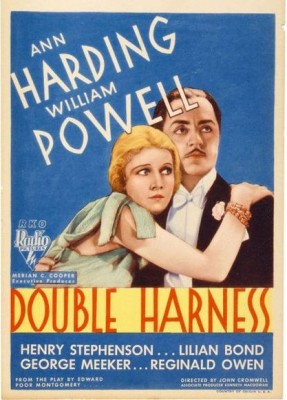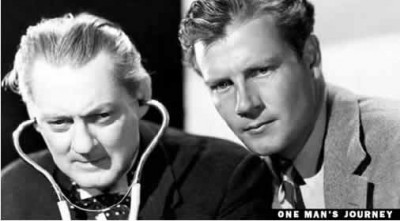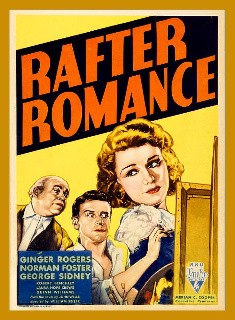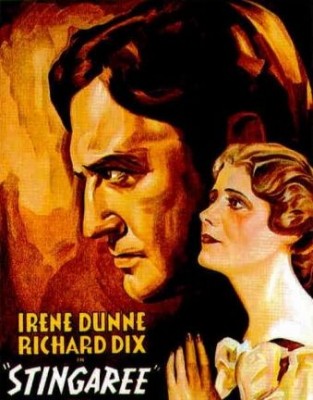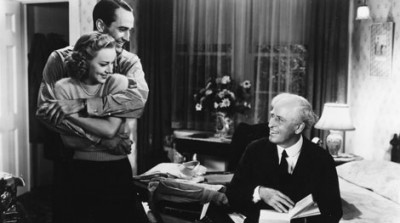| Reviews & Columns |
|
Reviews DVD TV on DVD Blu-ray 4K UHD International DVDs In Theaters Reviews by Studio Video Games Features Collector Series DVDs Easter Egg Database Interviews DVD Talk Radio Feature Articles Columns Anime Talk DVD Savant Horror DVDs The M.O.D. Squad Art House HD Talk Silent DVD
|
DVD Talk Forum |
|
|
| Resources |
|
DVD Price Search Customer Service #'s RCE Info Links |
|
Columns
|
|
|
Lost & Found RKO Collection (Double Harness/One Man's Journey/Rafter Romance/A Man to Remember/Stingaree/Living on Love), The
Clearly this is a set geared for a narrowly-defined audience - classical Hollywood movie buffs, with TCM trying to carve out a new niche market for obscure but desirable titles that even Warner Home Video is unlikely to ever touch. If it's successful we'll hopefully see similar sets or individual titles we'd never imagine being released in any form.
Retailing at $79.99 (but currently selling for around $65), it's not cheap but neither is it overly expensive considering what you're getting. I remember when the only way to own classic movies was on 16mm or Super-8 sound prints costing hundreds of dollars, or the early days of VHS when a single pre-recorded movie was nearly as expensive. I'd be surprised if TCM expects to sell more than a few thousand of these, making the DVD-R compromise seem quite reasonable to this reviewer. This set includes Double Harness, Rafter Romance, One Man's Journey (all 1933), Stingaree (1934), Living on Love (1937), and A Man to Remember (1938), and all include good extra features.
What do the six films have in common? Producer Merian C. Cooper (King Kong, The Searchers). It seems that in 1946 Cooper was embroiled in a dispute with RKO over his contracted profit-participation during his tenure there. As part of the settlement, RKO signed over all rights and the original negatives to the six pictures included in this set. Some of these films were eventually, albeit very briefly, shown on television in the New York market in the late-1950s - but otherwise have not been seen at all since their initial release more than 70 years ago.
Double Harness is a good example of the kind of thing denied film fans all these years: a romantic, proto-feminist, pre-Code John Cromwell-directed film starring Ann Harding and William Powell. Made near the height of the Great Depression but set among the carefree world of San Francisco's aristocracy, Double Harness stars Harding as Joan Colby, an intelligent older sister, the "steady, dependable one" who contrasts her spendthrift sibling Valerie (Lucile Browne). Soon after Valerie's marriage to Dennis (George Meeker), Joan - who admits she has no special talents or beauty - decides to "marry a man with a future, and make his future mine." Forever pragmatic, Joan puts fulfillment and self-validation ahead of love.
She sets her sights on incorrigible playboy John Fletcher (Powell), heir to the flagging Fletcher Shipping Line, which he has no use for. John finds Joan "coolly virginal yet exquisitely inviting," and immediately dumps Monica (Lilian Bond, who somewhat resembles Myrna Loy), his one-time "private preserves."
But there are some obstacles. To her surprise, Joan falls in love with John, despite his desire to continue sleeping with Joan without marrying her. She tricks him into a compromising position - she arranges to have her old-fashioned father (Henry Stephenson) discover them - and without much resistance agrees to do the honorable thing and marry her. However, once married the winds of romance vanish from John's sails and, like two mature adults they decide to wait a proper six months, living together cordially but lovelessly, and then get a divorce. Can their marriage be saved?
Double Harness is an interesting film in several respects. Though once a big star at RKO, the Oscar-nominated Ann Harding is almost totally forgotten today, and that's a shame. In this she's positively captivating, delivering a nuanced performance that's relaxed, confident, and in sharp contrast with more theatrical, stylized contemporaries like Bette Davis, Joan Crawford, and Katharine Hepburn. More along the lines of an Ann Dvorak or (early-talkies) Mary Astor, it's emotionally real without ever going over the top and the character is emotionally very strong and intelligent in an appealingly understated way.
She's a marvelous match with William Powell, on loan from Warner Bros., who's more or less playing his established screen persona, a persona that's charming in the weakest of films. Like his co-star, Powell is exceedingly good at underplaying emotion, often brushing aside conflict with his innate sophistication and breezy manner. The script by Jane Murfin (Alice Adams, The Women), adapted from a play by Edward Poor Montgomery, is adult, realistic, and modern, though salacious stuff in 1933. Joan and John have premarital sex, there's much talk about extramarital affairs, Joan's married sister toys with sleeping with another man solely to get money to buy expensive clothes, etc.
Ultimately though, this is a richly romantic film because in part it's so realistic (aside from all the fancy living) and because the performances sell the material so well, resulting in a highly rewarding payoff in the closing reel. Rating: (****)
One Man's Journey is a sentimental-in-the-good-sense melodrama starring Lionel Barrymore (on loan from MGM) and Dorothy Jordan, new wife of producer Merian C. Cooper (who'd return to acting after a long absence to play Martha Edwards in The Searchers), and featuring Joel McCrea and Frances Dee as young lovers (while off-screen they married for real shortly after this picture wrapped).
Barrymore is probably best-remembered today as Henry F. Potter, "the meanest man in town" (and Dick Cheney look-alike), Jimmy Stewart's rival for control of Bedford Falls in Frank Capra's It's a Wonderful Life (1946). In that film Stewart's character dreams of seeing the world and living up to his potential - but fate intervenes and he ends up spending his entire life caring for the residents of his Podunk of a small town.
One Man's Journey is virtually the same film minus Wonderful Life's fantasy elements, only this time Lionel Barrymore plays the self-sacrificing saint. As Dr. Eli Watt, money troubles and the unending needs of poor local residents constantly prevent him from leaving, and like Stewart's character Eli thinks he's wasted his life. In It's a Wonderful Life Stewart's George Bailey sends his brother off to college while he stays home; in One Man's Journey, Eli sends his son (McCrea) off to medical school (in Vienna) instead of advancing his own skills.
There are other bits of irony, too: In It's a Wonderful Life the pressure Lionel Barrymore's character puts on Pop Bailey (Samuel S. Hinds) sends him to an early grave; in One Man's Journey, Hinds plays an esteemed physician who pays tribute to Barrymore's Eli as a great humanitarian. And on and on.
One Man's Journey is melodramatic but not syrupy and cloying. Still Pre-Code, the picture is frank about premarital sex, and almost grim as Eli's small town faces one calamity after another (an outbreak of smallpox, etc.). The heart of the picture is Eli's relationship with an adopted daughter, Letty (Jordan). Her biological father, McGinnis (David Landau), rejected her after his wife died during childbirth; he holds a years-long grudge against Eli, blaming him for his wife's death.
Barrymore, who has a tendency to overact (or maybe it's simply performing in style more akin to turn-of-the-century theater vs. '30s/'40s cinema acting) is very understated here, and there is an interesting political undercurrent to the film, a realistic portrait of poor people clinging to the only doctor around not demanding cash payments up front for his services.* It's also interesting to see McCrea so early in his career (though in a fairly insignificant part) and Barrymore thin and not in a wheelchair, where he pretty much spent the rest of his career from 1938 onward. (*** 1/2)
Rafter Romance is the least of the Pre-Code titles; the entire picture revolves around a single idea that, as developed here, simply can't sustain its 73-minute running time.
Mary Carroll (Ginger Rogers, top-billed) and aspiring artist Jack Bacon (Norman Foster, later a director) live in the same Greenwich Village apartment building, "Ye Eckbaum Arms." Both are months behind in their rent to overtly Jewish landlord Max Eckbaum (George Sidney, not the later director). Rather than evict the likeable youngsters, Max imposes a solution: he moves Mary into Jack's attic loft. He works as a night watchman and only needs the apartment during the day (though he never seems to sleep), while she's found a day job and needs the unit only at night. Max makes all the arrangements, so Jack and Mary are never introduced as roommates, but coincidentally become acquainted outside their building, unaware they're sharing the same room.
With a premise like that, you know there's only two ways this story's going to go: they're either going to fall in love as roommates communicating via little notes while despising one another in person, or fall in love in person while loathing one another as roommates.
Rafter Romance opts for the latter approach, but it doesn't really work. Their face-to-face romance builds on a series of lies and misunderstanding so it never really contrasts the antipathy they feel as roommates. As roommates, they're spiteful to one another too quickly and without much justification, and their battles with one another are destructive instead of funny. Nor do these scenes generate much suspense as far as their "real" relationship is concerned - not that there's ever any doubt how it'll all end.
Instead, the film is mildly diverting for other reasons. For one thing, it's interesting to see Norman Foster, then married to Claudette Colbert, as an actor - physically he reminds me of a young John Agar - before he gave up acting to become a director at Fox, where he helmed numerous "Mr. Moto" and "Charlie Chan" movies. He's equally remembered for his long association with Orson Welles, and for his television work at Disney, especially the short-lived but hugely popular Davy Crockett series.
Rogers is fun, too - this having been made between roles in Warner musicals like 42nd Street and Gold Diggers of 1933 and just prior to Flying Down to Rio at RKO, her first film with Fred Astaire. I'm not much of a Ginger Rogers fan, but she's got a lot of spunk in this. As a telemarketer of state-of-the-art iceboxes, she impressively memorized long, jargon-filled sales pitches delivered at lightning speed. Being a Pre-Code title, the picture finds time to show Rogers in various stages of undress, particularly one scene that follows her as she strips and showers.
But by far the most stupefying moment involves Sidney Miller (yet another actor who'd turn to directing in later years), here about 16 years old and playing Max's son. In one scene Max catches his son enthusiastically drawing swastikas all over a wall in the building's entranceway as his father looks on, aghast. "Pop, it's for good luck!" protests the boy. Though Swastikas were symbols of good luck in many cultures prior to the rise of Nazism, this must have been a pretty outrageous gag even in 1933.
Less distasteful is Robert Benchley's supporting role in the film as Mary's amorous boss with persistent designs on her. Though a somewhat conventional role, Benchley makes the most of it. (Also working at the Icy Air Co. are Three Stooges regulars Bud Jamison and June Gittelson, as well as script supervisor and sometime-actress Ellen Corby.) (** 1/2)
Because it was directed by William Wellman and stars Irene Dunne and Richard Dix, Stingaree automatically is of interest, but the film is a weird, mostly unsatisfying hodgepodge of movie genres. When it casts raspy-voiced Andy Devine as a Cockney-accented Australian named Howie, you know something's not quite right.
Down under in 1874, Hilda Bouverie (Dunne) is the adopted ward, a servant girl really, working at the sheep-farming estate of Mr. and Mrs. Hugh Clarkson (Henry Stephenson and Mary Boland). Mrs. Clarkson dreams of becoming a star soprano but is tone deaf, quite unlike Hilda, the real talent of the household. Naturally Mrs. Clarkson, feeling threatened by Hilda, wants to suppress the young woman's talent when famous London composer Sir Julian Kent (Conway Tearle) pays the family a visit.
However, Sir Julian is kidnapped en route by the rascally rogue Stingaree (Richard Dix) and his manservant (Devine). The police hot on his trail, Stingaree shows up at the Clarksons pretending to be Sir Julian. The ruse is quickly discovered, but not before the Stingaree, impressed by Hilda, maneuvers Sir Julian into sampling her exquisite voice. Though Stingaree's gesture only lands him in prison, he neither regrets his decision nor expects she'll ever return to him. But of course she falls madly in love with him.
Stingaree is an odd one. It doesn't really work, this peculiar jumble of Scaramouche, B-Westerns, and Jeanette MacDonald-Nelson Eddy operettas. The inauthentic look of the film - Charles Dickens by way of Oxnard scrub country - works against it too; at times the film suggests Young Pip Goes West. The cast is good, however, and it's fun to see Dix in such an unusual role. (** 1/2)
The last two films are both remakes. A Man to Remember is a B-movie reworking of One Man's Journey, with Edward Ellis, Anne Shirley, and Lee Bowman in the roles played by Barrymore, Dorothy Jordan, and Joel McCrea, respectively. Though modestly produced for somewhere between $80,000 and $120,000 (the DVD's own production notes are contradictory), it improves upon the original and is a model remake in all respects. Screenwriter Dalton Trumbo obviously studied the original material carefully, and almost all his changes are good ones. Another acclaimed playwright/screenwriter, Garson Kanin, made his directorial debut with this film.
The remake follows the original quite closely; the changes are relatively small but add to the film's overall effectiveness. Mainly Trumbo made the interesting decision to tell the story in flashback, with the film opening as the funeral procession for Dr. John Abbott passes through town while at the second-floor offices of an attorney (Charles Halton), three of the dead man's creditors have gathered. Opening a strongbox, they peruse Abbott's papers, with various promissory notes and receipts introducing the flashback sequences.
This device, with the three vulture-like businessmen highly dismissive of Abbott's accomplishments while on the street ordinary townsfolk reverently pay their respects to Abbott's passing coffin and state funeral-like procession, carries more weight than the better-late-than-never recognition Barrymore's selfless sawbones receives from his peers at the end of One Man's Journey. The liner notes hint this film's structure directly influenced Citizen Kane but the more obvious parallel is with Akira Kurosawa's Ikiru (1952). That film turns on a funeral scene midway through in which local government officials dismiss a minor bureaucrat after his death, which is then contrasted with the deep mourning of local citizens who recognize his indefatigable determination to build a children's park, an accomplishment traced via flashbacks. Interestingly, like Ikiru, Trumbo's script also makes the son more self-involved than McCrea's character was; once he graduates from medical school he puts some distance between himself and father.
Trumbo's script also dumps some of the original's more melodramatic elements while subtly adding a more biting condemnation of businessman who get rich off a community they steadfastly refuse to give back to, and even recklessly put in harm's way to protect their investment. (Here a polio scare is threatened because the businessmen don't want to cancel a county fair they've invested heavily in.) When the son of a local banker accidentally shoots Abbott's daughter in the arm, Abbott essentially blackmails the banker, George Sykes (Granville Bates, very good), into building a community hospital. (Cost: $40,000!) For this the banker is lauded as a great humanitarian while his wife claims, quite untruthfully, that it had been her husband's dream project for many years. Behind the scenes, the great humanitarian has Abbott blackballed from practicing there.
Edward Ellis was a familiar but not at all famous name in films; he's probably best remembered today as the literal "Thin Man" in the film of the same name, a role usually erroneously ascribed to star William Powell. He's somewhat better than Barrymore in that he's both subtler and less overtly folksy, and as written he's also a bit less eager to be liked and quicker to condemn other people's greed. The film was a real sleeper and even made The New York Times' list of the year's best films, unusual for such a minor film. (****)
There's not much to say about Living on Love, a minor remake of the minor Rafter Romance. Unlike A Man to Remember, in adapting the original film the screenwriters made only cosmetic changes to the story, moving the apartment from the attic to the basement, changing the girl from a telemarketer to a door-to-door salesgirl hawking Aladdin Electric Shavers instead of iceboxes, and so on. Maybe producer Cooper like the name "Eli W-something" (as in Eli Watt) because this time the landlord is named Eli West.
Overall it's a little bit better than Rafter Romance, at least for those not infatuated with Ginger Rogers, because it takes its slight premise and works it into a much shorter film, this running just 61 minutes. Also, the two leads are more appealing, though both this and A Man to Remember are basically no-star pictures. Whitney Bourne, in the Ginger Rogers part, appeared in less than a dozen films between 1934-39. She had prominent parts in two Ben Hecht/Charles MacArthur films, made a film in England, then was plugging away for B-movie director Lew Landers at RKO. She's less brassy, more sophisticated than Rogers, and her unknown quantity itself makes Living on Love a bit more appealing.
James Dunn, on the other hand, was a steadily employed light character comedian in films through about 1950 when he got into television and kept busy there until his death. He's fleshy and middle-aged in this, not handsome like Norman Foster was in Rafter Romance, but a lot funnier to watch. Other than Tom Kennedy, about the only other actor of note in this is fussy Franklin Pangborn, playing the part of Bourne's amorous boss, Ogilvie O. Oglethorpe (the kind of name that works in the universe of W.C. Fields and nowhere else). Pangborn's casting as a hot-blooded sexual predator is, well, a bit of a stretch. (***)
Video & Audio
All six full-frame, black & white films in The Lost & Found RKO Collection are about average, video and audio-wise, comparable to other RKO titles from the same 1933-38 era in the main library held by Warner Bros. - in other words, the film elements aren't in great shape compared to, say, Warner Bros., and MGM films from the same period, but still perfectly watchable with decent audio.
The Region 1 discs have no subtitles options, but are closed-captioned. The use of DVD-Rs will annoy some, but other than taking very slightly longer to load into one's player, I don't regard this as a capital offense. The films all played just fine, and look no worse than standard DVD releases.
Double Harness includes restored footage cut for its brief TV run, while the only known surviving and usable film element available for A Man to Remember's transfer was a Dutch-subtitled nitrate print from the Netherlands. It looks quite nice and the white subtitles aren't particularly distracting, but TCM goofed Big-Time in one respect: Throughout the film, particularly in facilitating all those flashback scenes, are close-ups of promissory notes, receipts, pages out of medical books, etc. On this print, new inserts were filmed with the documents in Dutch, and yet none of these inserts have been English-subtitled for the DVD, which would seem an obvious necessity. This isn't ruinous but after a while it gets pretty grating because it so easily could have been avoided.
Sticking out like a sore thumb is the music heard under the main menu screens, arguably the most inapt ever. Although these films all date from the 1930s, the music frequently used is a kind of generic techno-pop, like some would-be musician at TCM slipped in their garage band's demo tape. For Kinjite - Forbidden Subjects maybe, but Double Harness? Uh-uh.
Extra Features
Supplements are plentiful. The Rudy Behlmer Video Commentaries accompanying each film are actually short, often-spoiler filled introductions that helpfully put the films into context while pointing out interesting bits of trivia the viewer may have missed. Each title also includes a TCMdb Article & Information with background on each film's production, some of it drawn from the American Film Institute Catalogs; it's helpful and interesting. Behind-the-scenes photos, scene stills, publicity stills, posters, pressbooks, lobby cardsand even odds and ends like glass slides and sheet music accompany the titles in various combinations. Trailers for Double Harness, Rafter Romance and Living on Love are also included.
Finally, ten-minute excerpts of archive interviews with directors Garson Kanin and William Wellman round out the package. Neither talks about the film at hand and though interesting enough, these brief interviews play more like fleeting introductions to each filmmaker's personality than actually provide any useful information.
Parting Thoughts
Of The Lost & Found RKO Collection's six films, really only Double Harness and maybe A Man to Remember impressed me enough to ever want to watch them again, or eagerly loan them to friends who might find them worthwhile, but the other four still had their moments, and I'd really like to see more boxed sets like this one. For classic Hollywood fans, this is Highly Recommended.
* Not that anything's changed. Some years back, in Michigan, I called for an ambulance on behalf of a an elderly woman critically ill with pneumonia. Their first words after I gave them the address: "Cash or charge?"
Film historian Stuart Galbraith IV's latest book, The Toho Studios Story, is on sale now.
|
| Popular Reviews |
| Sponsored Links |
|
|
| Sponsored Links |
|
|
| Release List | Reviews | Shop | Newsletter | Forum | DVD Giveaways | Blu-Ray | Advertise |
|
Copyright 2024 DVDTalk.com All Rights Reserved. Legal Info, Privacy Policy, Terms of Use,
Manage Preferences,
Your Privacy Choices | |||||||









